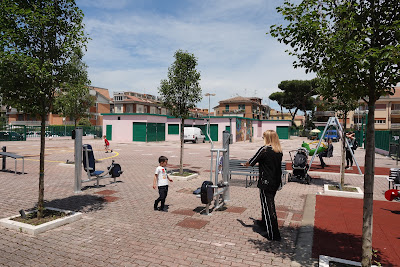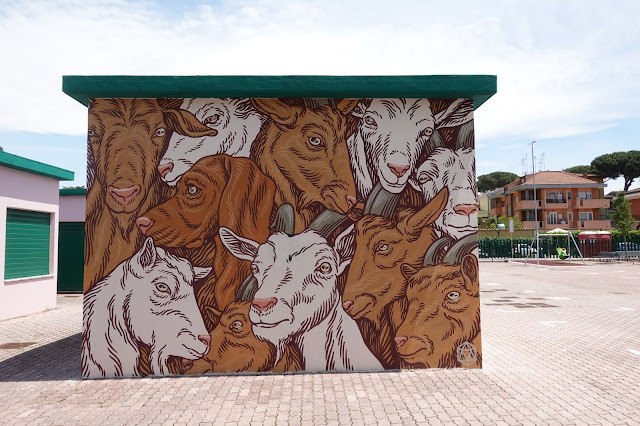We've known about Quarto Miglio for some time, because our son went to school there in 1993, when
RST's Rome adventure began. It's basically just a small town--population about 11,000--located to the southeast of Rome's center. The name comes from its location at the 4th Roman mile of the Appian Way (
via Appia Antica). The area was settled in Roman times, and many of its streets are named after ancient Romans.
As a modern community, Quarto Miglio dates to the 1920s, when construction of new buildings accelerated. The parish was established in 1935, and the church of San Tarcisio (on the main drag, via di San Tarcisio) was completed in 1939. San Tarcisio was a 3rd-century Christian martyr.
Among those who once lived in Quarto Miglio are movie director
Franco Zeffirelli, Gina Lollobrigida, and fashion designer Valentino (though they no doubt lived in large villas on the ancient Appian Way, not in the town center).
 |
| Poster announcing the celebration for the opening of the new market and playground |
We were ready to touch base once more with Quarto Miglio, because we had read about the construction there of a new market, complete with wall murals by, among others,
Luca Maleonte and
Diavù . The opening of the new market had taken place on a Friday evening, complete with music and calisthenics (to celebrate a new, outdoor activity center). But we couldn't make the Friday opening, so we headed out on the scooter the next day, arriving about noon.
We found the new market easily enough. It consists of about 10 small, separate buildings, designed for individual merchants. When we arrived, only one of them was occupied and open, a fruit-and-vegetable seller. He told us that heavy rain had pretty much ruined the opening, and then lamented the lack of traffic at the new market.
The nearby exercise area was not much more active--a few mothers with their kids, who were playing on the newly installed equipment.
 |
| Playground in foreground, market in background |
Behind them, a school wall displayed paintings designed to appeal to children--not art by any means, but pleasant enough:
On the back and side walls of the market stands we found a few more artful pieces (below).
 |
| Could be Diavù -referencing nearby via Appia |
 |
| Looks like Luca Maleonte. Playground is back right. |
Bummed out by the lack of activity at the market and playground, we headed for the "town" center, which was a few blocks away. More life there, including a
caffetteria in a small piazza, with some folks hanging out at unshaded tables, and a
sartorie (seamstress), located in a bright storefront.
And we think we found the 1939 church of San Tarcisio:
On a side street, we came across a handsome building in the neo-medieval style, probably dating from the 1920s:
Another small piazza,below, this one featuring some elegant pines, a modernist apartment building with a balcony jutting out over the stone walkway, and a couple of shops. In one of them, we were lucky to find some tennis balls, for a friend who needed them--and not for tennis.
And a wiry cat, enjoying a high window ledge that it had somehow managed to scale.
That's our Quarto Miglio "adventure." Disappointing in some ways, modestly satisfying in others--sometimes that's how things work out. And it's what we do.
Bill
 Rome's winters are often cold and rainy. But now and then the rain turns to snow. The kids love it, and the adults find the camera and take pictures before the melting begins, often in minutes. It happened on February 12, 2010, and our friend Massimo found the camera and took these shots from the windows of his apartment near Piazza Bologna. That's our beloved Malaguti (below, since replaced by a Honda Forza 300), right next to the sideways-parked Smart car, covered in the white stuff. Looks like Christmas--soooo, Merry Christmas and Happy Holidays!
Rome's winters are often cold and rainy. But now and then the rain turns to snow. The kids love it, and the adults find the camera and take pictures before the melting begins, often in minutes. It happened on February 12, 2010, and our friend Massimo found the camera and took these shots from the windows of his apartment near Piazza Bologna. That's our beloved Malaguti (below, since replaced by a Honda Forza 300), right next to the sideways-parked Smart car, covered in the white stuff. Looks like Christmas--soooo, Merry Christmas and Happy Holidays!


